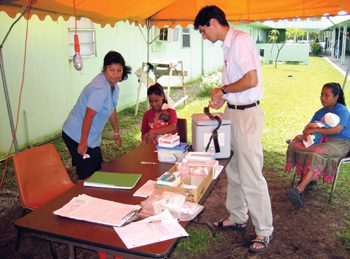
Fourth year medical student Tony Khalifah helps distribute measles vaccinations in the Majuro Atoll in the Republic of the Marshall Island.
Student investigates measles outbreak in the South Pacific
Tony Khalifah was in the right place at the right time.
Two weeks into an elective rotation at the Centers for Disease Control and Prevention in Atlanta, the fourth-year medical student was sent with the CDC’s National Immunization program for five weeks to the Majuro Atoll in the Republic of the Marshall Islands, which is located in the South Pacific, to help investigate a widespread measles outbreak. He was the only medical student working with the group of CDC epidemiologists and the Ministry of Health in the Republic of the Marshall Islands to investigate the outbreak, which affected more than 700 people.
About 60 people were hospitalized during the outbreak, which lasted from July through September, and three died — a 15-month-old malnourished child and two women.
“I’m pretty sure no other student in this medical school has seen measles. We learn about it, but we don’t see it,” Khalifah said. “It’s easy to forget that in the world 700,000 people a year die from it because we don’t see it in the United States much at all.”
In fact, there are fewer than 100 cases in the United States each year. Prior to 1963, almost everyone got measles. Each year in the United States there were approximately 3 to 4 million cases and an average of 450 deaths. Epidemics occurred every two to three years. More than half of the population had measles by the time they were 6 and more than 90 percent had it by the time they were 15. After the vaccine was first licensed in the United States in 1963, the number of measles cases dropped by 98 percent. However, tow doses of the measles/mumps/rubella vaccine are recommended for children.
Between 1985 and 1988, many measles cases occurred in children who had been vaccinated, leading officials to realize that children who received only one dose were not always protected from the disease. A second dose was recommended for children between 5 and 19 to ensure protection for those who had not received immunity from the first dose. Symptoms of measles include rash, high fever, cough, runny nose and red, watery eyes.
Dr. William Schaffner, professor and chair of Preventive Medicine and a former investigator for the CDC, said that the government agency wishes to attract bright young men and women into public health and preventive medicine careers, and has chosen to offer the elective so that these students can see what the practice of public health is like at the national level. Most medical schools do not have the resources to offer a clerkship or a significant learning experience in public health or preventive medicine. Students are assigned to a project, which may include parasitic diseases, food borne illnesses or hospital-associated infections.
“It’s a wonderful opportunity to be part of a cavalry coming across the hill to rescue the settlers,” Schaffner said. “These people from the CDC come into an environment amidst social disruption and have to make sense out of that, help figure out a problem, and how to control an outbreak, then how to prevent future outbreaks. It’s a very high intensity, hard-working, no-sleep experience. It’s like working in the public health emergency room.”
To help contain the outbreak, the Ministry of Health imposed travel restrictions on anyone between the ages of six months and 40. They had to either show prior documentation of having the measles vaccine or get vaccinated before they could travel between islands or leave the islands. Khalifah had to call Vanderbilt to have his vaccination records sent before he could leave the Marshall Islands, he said.
“We also met with several foreign ambassadors to brief them on the outbreak and containment strategies,” he said.
It’s unusual to see a disease like measles in an island population since measles would normally be seen in a place that’s not so isolated, Khalifah said. “It spreads rapidly across land, but can’t jump across the islands well so we had interesting measles presentations.”
It’s more serious for people older than 30 to get measles, and the group saw a number of cases in people over 30. Most babies also don’t get it within the first six months of life, but the group saw a number of cases in that age group as well. With an incubation period of 7 to 18 days, the CDC group could see waves of cases coming as they tracked the outbreak during their 12-hour workdays.
“It’s the best month of medical school I’ve had without question,” Khalifah said. “It’s really great to be doing practical work. It’s a thing you dream of, going on an extended outbreak. Most outbreaks aren’t so long or exciting. I got lucky.”













